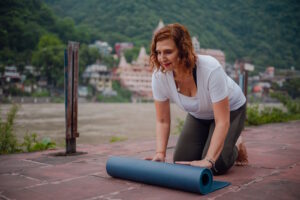
Pilates is well-known for its effectiveness in promoting strength, flexibility, and body awareness. However, Pilates equipment also plays a vital role in rehabilitation and injury prevention. With its versatility and adjustability, Pilates equipment provides support, resistance, and targeted exercises that aid in the recovery process and help prevent future injuries. In this article, we will explore the equipment used in Pilates, discuss how Pilates helps prevent injury, examine the use of Pilates in rehabilitation, and highlight the advantages of incorporating Pilates equipment into rehabilitation programs.
What equipment does Pilates use? Pilates utilizes various pieces of equipment to enhance the practice and facilitate rehabilitation. The most common Pilates equipment includes the reformer, Cadillac (trapeze table), Pilates chair, ladder barrel, and spine corrector. Each apparatus offers unique features and benefits. The reformer, for instance, consists of a sliding carriage, adjustable springs, and straps, providing resistance and support for a wide range of exercises. The Cadillac offers vertical bars, straps, and springs that assist with stretching, strengthening, and mobilizing the body. The Pilates chair focuses on balance, stability, and strength through seated or standing exercises. These versatile pieces of equipment allow for customization and targeted work, making them invaluable in rehabilitation settings.
How does Pilates prevent injury? Pilates is a holistic exercise method that emphasizes core strength, proper alignment, and body awareness, all of which contribute to injury prevention. By targeting deep stabilizing muscles, Pilates enhances postural alignment and improves muscular balance. The controlled and precise movements in Pilates promote safe and efficient body mechanics, reducing the risk of overuse injuries and muscular imbalances. Additionally, Pilates exercises often involve low-impact and joint-friendly movements, minimizing stress on the body. The focus on core stability and proper alignment in Pilates enhances overall body mechanics, leading to improved movement patterns and decreased susceptibility to injuries.
What is the use of Pilates in rehabilitation? Pilates is widely used in rehabilitation settings due to its adaptability, progressive nature, and focus on functional movement. Pilates exercises can be modified to suit individuals with varying levels of strength, flexibility, and mobility. The equipment used in Pilates provides targeted resistance and support, making it beneficial for rehabilitating specific injuries or addressing post-surgical recovery. Pilates helps in restoring and improving joint mobility, enhancing muscular strength and endurance, promoting flexibility, and facilitating neuromuscular retraining. The mind-body connection fostered in Pilates encourages body awareness, helping individuals to move more efficiently and effectively during the rehabilitation process.
What are four advantages of the use of Pilates in rehabilitation?
1. Targeted Exercise: Pilates equipment allows for targeted exercises that focus on specific muscle groups, joints, or movement patterns, facilitating the rehabilitation process. The adjustable resistance of the equipment enables progressive strengthening and conditioning tailored to individual needs.
2. Core Stability and Alignment: Pilates emphasizes core stability and proper alignment, which are crucial for maintaining a stable and well-supported body during rehabilitation. Improved core strength and alignment contribute to overall body mechanics, reducing the risk of re-injury.
3. Low-Impact and Joint-Friendly: Pilates exercises, particularly when performed on equipment, are low-impact and gentle on the joints. This makes Pilates suitable for individuals with joint issues or those recovering from surgeries, allowing them to exercise safely and effectively.
4. Mind-Body Connection: Pilates promotes a mind-body connection, helping individuals to become more aware of their body and movement patterns. This heightened awareness enhances motor control, coordination, and proprioception, facilitating a more efficient rehabilitation process.
In summary, Pilates equipment is invaluable in rehabilitation and injury prevention. Pilates exercises and the use of specialized equipment aid in restoring mobility, improving strength and flexibility, and promoting proper alignment and body mechanics. Pilates helps prevent injuries by focusing on core stability, alignment, and mindful movement. The adaptability, progressive nature, and targeted exercises provided by Pilates equipment make it a highly effective tool in the rehabilitation process, offering advantages such as targeted exercise, core stability, low-impact movements, and a mind-body connection. Incorporating Pilates equipment into rehabilitation programs can facilitate recovery, improve functional movement, and reduce the risk of future injuries.